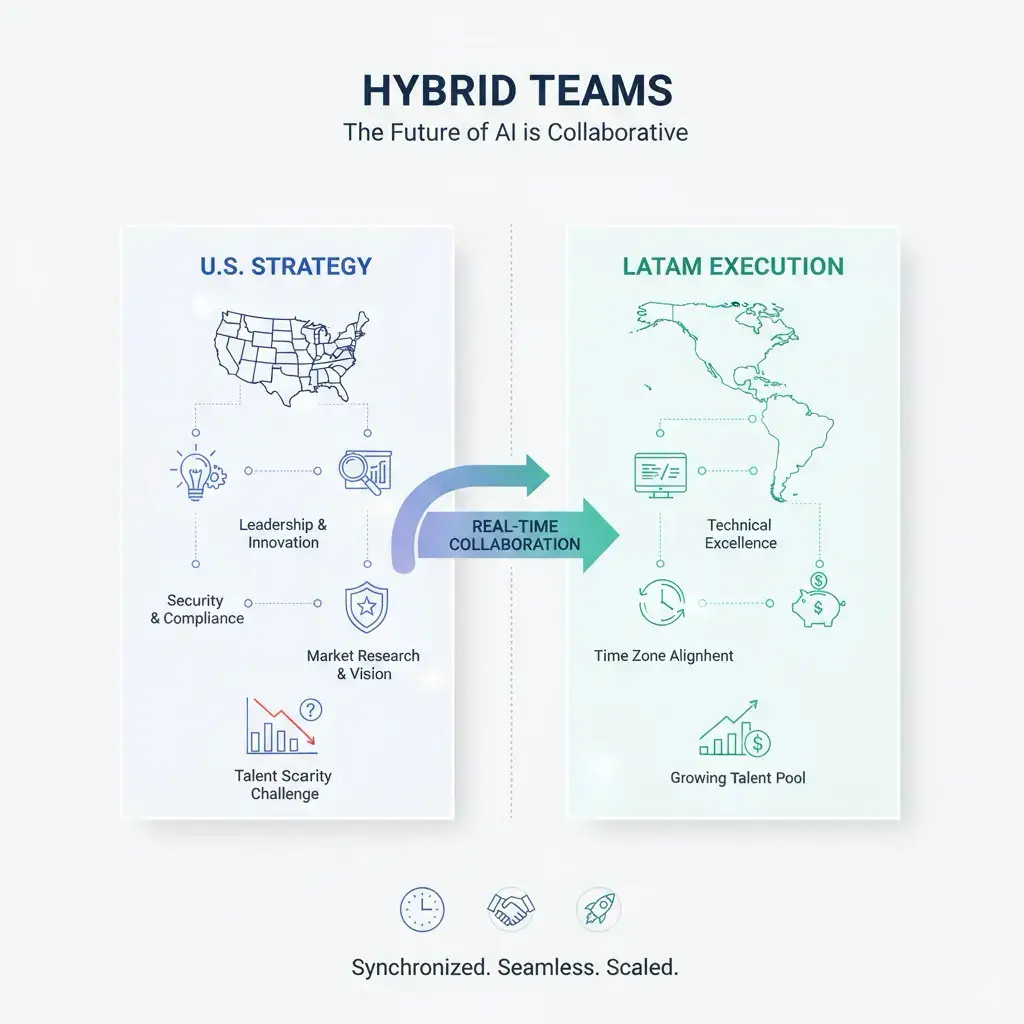The Rise of Hybrid AI Teams
Artificial Intelligence isn’t just buzz—it’s becoming foundational. Across healthcare, finance, logistics, and e‑commerce, AI systems ship faster, detect fraud, personalize experiences, and streamline operations. The only obstacle? Talent. In the U.S., hiring AI‑literate teams—programmers, engineers, prompt‑wranglers—is slowing innovation.
Compound this with the “Great Hesitation”: economic uncertainty and shifting priorities have companies pondering who to hire—and how to skim off critical human bandwidth for AI work. Meanwhile, demand for AI skills continues to surge. CompTIA’s AI Hiring Intent Index shows job postings requiring AI fluency have jumped by approximately 153% year‑over‑year.
This talent squeeze has companies flipping their playbook on traditional offshore outsourcing. Instead of handing work off to distant vendors, today’s best‑in‑class tech teams anchor strategy in the U.S. and scale execution through nearshore LATAM talent. The result: real‑time collaboration, cultural cohesion, and technical depth—without the night‑owl conference calls.
Why Hybrid, Not Fully Outsourced
Offshore outsourcing has long been the “go‑to” cost lever. But those projects often stumble on time zone misalignment, hand‑offs, and fragile delivery. Hybrid nearshore teams fix this by collapsing distance.
- U.S. leadership retains strategic direction and customer proximity.
- LATAM developers accelerate execution with technical excellence.
- The result is one team, not two—and far stronger iteration velocity.
The Advantages of LATAM Talent in AI Projects
Time Zone Alignment
Time zone overlap isn’t just handy—it’s a productivity multiplier. Companies working with LATAM talent from Mexico to Argentina enjoy largely synchronous hours, enabling same‑day meetings, faster feedback, and fewer miscommunications.
Cost Efficiency
LATAM labor costs are significantly lower than those in the U.S. While exact percentages vary, analysis by outsourcing specialists notes clear operational savings—without sacrificing quality.
Growing Market Opportunity
The LATAM IT services market isn’t just growing—it’s booming. In 2024, the region generated around $70.9 billion in revenue. This is expected to grow at a compound annual rate (CAGR) of 10.1%, reaching approximately $126 billion by 2030. Other projections estimate outsourcing volumes in LATAM hitting $27.6 billion by 2028.
Human Capital
Latin America graduates and cultivates thousands of skilled engineers from Argentina to Brazil—developers excelling in Python, TensorFlow, PyTorch, AWS SageMaker, and more. These are not novice coders—they’re experienced, resilient, and purpose‑driven.
Market Validation: Numbers Without Hype
Let’s keep this clean and real:
- Job demand for AI‑fluent roles soared 153% year‑over‑year per CompTIA’s AI Hiring Index.
- Hybrid‑sales models generated up to 50% more revenue in McKinsey’s B2B sales research. While not directly about staffing, it confirms hybrid approaches drive value in modern workflows.
- LATAM outsourcing will generate nearly $60 billion in IT services in 2025, growing steadily on emerging tech.
- Time zone overlap speeds project turnaround by up to 30% in aligned teams.
Building “Super-Hybrid” AI Teams
True hybrid teams aren’t patched together—they’re architected to feel internal, cohesive, and high‑velocity.
- Shared toolchain: GitHub, Jira, Slack, CI/CD pipelines.
- Unified ceremonies: sprint planning and retrospectives in real time.
- Ownership parity: LATAM developers own and deliver features—not just fix bugs.
Human + AI Collaboration
GenAI isn’t fantasy—it’s already sharpened our tools. Platforms like Copilot, Code Whisperer, and generative test assistants speed routine tasks, letting engineers focus on strategy, architecture, and problem-solving. This human + AI co-driver boosts code quality, sprint cycles, and innovation velocity.
Overcoming Cultural & Operational Challenges
Even a clean Swiss watch needs calibration. Hybrid nearshore teams scale when you:
- Onboard thoroughly—culture, tech stack, cadence.
- Measure with shared KPIs—velocity, quality, uptime.
- Run agile rituals together mirroring local norms.
- Infuse leadership insights—resource distribution, alignment, and feedback loops tighten connection and collaboration.
Case Studies and Success Stories
Auction.com
A mega U.S. real estate marketplace handling billions in distressed property transactions.
Challenge: Scale engineering—web, mobile, AI, data—amid U.S. hiring shortages.
Solution: A Mahisoft-facilitated hybrid team of 20+ LATAM engineers deeply embedded across functions.
Result: Faster delivery timelines, stronger compliance posture, and long-term team coherence.
Tiempo Development
An Arizona firm that grew using nearshore capacity in Mexico—eventually acquired by 3Pillar Global.
Result: Increased throughput, improved cost control, and quality retention through hybrid scaling.
Future Outlook – Hybrid as the New Default
Generative AI is redefining work across LATAM. An arXiv survey on Brazilian firms found a blend of optimism and cautious curiosity, especially in sectors like coding, customer service, and design.
Hybrid teams armed with AI tools are evolving into a strategic differentiator. Expect deeper AI integration, smarter delivery pipelines, and hybrid nearshore structures as the norm, not alternative.
Conclusion – Why Hybrid US + LATAM Wins
Here’s what hybrid nearshore gives you:
- Strategic alignment: U.S. leadership, LATAM delivery.
- Real-time execution: Shared time zones, cultural affinity, faster sprints.
- Cost efficiency and quality: High-caliber development at sustainable rates.
- Verified ROI: Case studies that don’t rely on hype.
Call to Action: Need to scale AI or software initiatives without U.S. hiring delays? Mahisoft offers Nearshore Staff Augmentation, delivering the top 3% of LATAM developers. They integrate like your own, align with your time zone, and stay flexible—so your AI vision isn’t held back.


